Brian May/Fryer AC30s:
Please note: this page has the same content as my ‘Brian May Fryer AC30’ page.
https://fryerguitars.com/brian-may-fryer-ac30/
23rd October 2023:
During 2024 I am hoping to make a more comprehensive Brian May/Fryer AC30 page which details the evolution of my ‘We Will Rock You’ theatrical production Vox AC30 design which began in late 2003, through to the Brian May AC30s designed and built in mid 2005, the 2007 mods to those BM AC30s, to my later other versions of custom AC30 designs.
Included will be drawings and photos of the 2011-12 redesign and rebuilding I did to a Chinese made AC30BM amp for Japanese luthier Kazutaka Ijuin.
During the designing and building of the WWRY and Brian May AC30s which began in 2003, Sydney amp tech guru and transformer maker Martin Kell gave me a great deal of technical help and also general information about Vox AC30s – from the old original JMI amps right through to the modern ones.
From 2003 until 2009 Martin generously gave me extraordinary insights from his many decades of guitar amp and transformer building and repair. During this time I compiled Martin’s information in my many ‘AC30 technical books’. In the future when time permits I hope to condense and re-write this information for this website.
The contributions from Martin Kell and from Melbourne transformer maker Paul Voller were an essential part of the success of these unique amplifiers.
========================================================
Premier Guitar’s 2014 ‘Brian May Rig Rundown’ video gives an excellent tour of Brian’s 2014 Queen + Adam Lambert touring guitar/amp rig including a good explanation by Pete Malandrone of the 3 main Brian May/Fryer AC30s at about the 28:00 minute mark:
Vox AC30 redesign and 100% custom rebuild for 3 AC30s made for Brian May in 2005, which I later modified/upgraded in 2007:
The Brian May AC30 rebuild used the Vox AC30 TBX UK made 1994-2004 series speaker cabinet and integral head chassis as the starting point. All electronics and transformers were first discarded from the amp head. Some of these, notably the Drake output transformer, were reasonable quality but were not used in favour of higher quality custom design transformers which were hand made by Australian transformer experts Martin Kell and Paul Voller. The steel plated head chassis was then cleaned down and drawn up for drilling of mounting holes for valve sockets, larger choke and tagstrip mounts.
The whole amp head was rebuilt from scratch using the custom designed handmade mains choke and output transformers, over rated resistors, and good quality coupling and electrolytic capacitors which I preferred the sound of, all hand soldered on tagstrips like the best of the 1960s and 70s AC30s were. The AC30 circuit is my tweaked version of the AC30 based on my own preferences from the 1960s and 1970s amps along with a few custom touches thrown in.
During my March 2007 visit to Brian’s Allerton Hill studio, I conducted several modifications to Bob’. Amongst those mods, I removed the original GZ34 valve rectifier and socket and in its place fitted a small 1N4007 silicone diode tagstrip which was bolted to the same 2 mounting holes in the chassis that the GZ34 rectifier socket previously had been.
Several other modifications were done to the amp’s circuit, and lastly I replaced the two G12H speakers which I fitted originally in 2005 with 2 Celestion Alnico Blue speakers.
Bob’s modifications were done on the final day of a very busy visit to London which involved: negotiations with all parties involved in the Brian May Super guitar project, visiting pickup maker Adrian Turner, visiting Nigel Knight and conducting further Deacy Amp research with him, comparing our 2007 Deacy Amp prototype and the original Deacy Amp with Brian in the studio, plus other things as well.
It was on the final day of my visit that I did the mods to ‘Bob’, and I asked Pete Malandrone to later take Brian’s 2 other Fryer AC30s ‘Rag’ and ‘Tag’ to Mike Hill to have the same mods done to those two amps.
In coming months I intend to detail with photos and schematics both the 2005 version of the Brian’s amps, and the 2007 version mods that I did to ‘Bob’.
Version 3 BM/Fryer AC30 is pictured below featuring the same silicone diode rectifier as I fitted to ‘Bob’. The amp pictured below was built in 2010 for a UK customer and has a few extra features that were not on Brian May’s 3 Fryer AC30s, however it is substantially the same.
————————————————————————————————
Silicon Diode rectifier fitted to the Brian May/Fryer AC30 ‘Bob’ in 2007 and used on later BM AC30s built for other customers:
On the Brian May Fryer AC30 amp ‘Bob’ I originally used a GZ34 valve rectifier but in 2007 changed this to a 1N4007 silicone diode rectifier. The diodes are soldered to a small square tagstrip which is mounted on 2 standoffs which bolt straight into the GZ34 octal socket mounting holes in the chassis.
In the photo below the small square rectifier tagstrip is seen at below right. It can be picked out due to its 6 small black diodes and its 2 red fibre washers.
Silicone diode rectifier 1N4007 tagstrip is above at right, the small square tagstrip with 6 black diodes and the 2 red fibre washers
==========================================================
The article below was written by Simon Bradley for Guitar Magazine UK and is very informative. It was published on the internet on12 October 2016.
Amongst the text I have added my own comments below, to both flesh out with more contextual fact and explanation some of the comments made by Pete Malandrone and Mike Hill, and in one instance to provide a slight correction. I hope you enjoy reading it.
See Guitar Magazine article link here: https://www.theguitarmagazine.com/features/brian-may-ac30/
Brian May’s AC30-powered Queen Backline Up Close
Granted exclusive access to Brian May’s stunning collection of Vox AC30s, G&B goes where no guitar mag has been before to find out what it takes to keep Brian’s amps operational on the road, why they’re now more reliable than ever and just why the Queen guitarist will never use anything else…
Story Simon Bradley | Photography Eleanor Jane
The Vox AC30 Twin, introduced in the spring of 1960, has its unmistakable tone all over the very beginnings of guitar-based popular music, and some of the greatest English bands ever have plied their trade through this most revered of combination amplifiers.
A band utterly synonymous with Vox are, of course, The Beatles, and the documentation of John Lennon’s first purchase of a Vox amp – an AC15 Twin bought on 27 July 1962 from Hessy’s Music in Liverpool – still exists. By early 1963, the band were well on their way to becoming the biggest band of all time and both Lennon and George Harrison had moved on to the classic black/brown AC30, with amps provided by Vox after manager Brian Epstein had reached an agreement with the Brit amp manufacturer. Paul McCartney also used an AC30 for a few shows around that time, albeit the head version called the Super Twin, fed into his trusty T-60 2×15 cabinet.
Rolling Stones guitarists Keith Richards and Brian Jones also used AC30s for a time after bassist Bill Wyman introduced them to his own Vox amp, as did both the Clapton and Beck incarnations of The Yardbirds; needless to say, the list goes on and on.
One of numerous road cases that have been around the world with Brian many times
The Beatles, the Stones and Jeff Beck were just some of the heroes an unassuming student named Brian Harold May looked up to. With assistance from his father, he’d spent 18 months building an electric guitar from scratch, one that would become known the world over as the Red Special. For amplification purposes, he had graduated to a Burns Orbit combo after years spent at home noodling through a Collaro tape deck’s preamp he’d plugged into a homemade radio. May and his bands, first 1984 then Smile, were fitting in as many gigs around their academic studies as they could, but the young guitarist was growing concerned that he’d never achieve the sounds he had in his head.No stranger to the venues of the capital, Brian went to London’s Marquee Club one night, as he often did, little knowing that his quest for just the right tone was coming to an end.
May’s pedalboard is operated by Pete Malandrone from the side of the stage
“Hendrix was all about the guitar and the amplifier, and it had that sort of wonderfully smooth, almost orchestral distortion,” Brian told this writer in 2013. “I wondered how you did that, and the answer was actually given to me by Rory Gallagher. I used to go and see him every Thursday night at the Marquee and, after the gig, we’d sneak into the back rooms when everyone was leaving so we’d be able to see him.
“He was the nicest, most patient guy you could imagine. He told me about his guitar and a little box called a Rangemaster treble booster. He showed me his amps and said that he used the Vox amps because ‘…they just speak’.
“A bunch of us went down Tottenham Court Road to a second-hand amp shop called, I think, Take 5, and they had a few Vox AC30s, beaten up and all in a row.
The chassis is eased from an AC30. “I tend to get them serviced more regularly than they need to be,” says Malandrone
“I plugged my Red Special and a Rangemaster that I’d found into one of these amps and the sound was just there. It had that depth, the overtones, the sustain, and the throaty splutter. I just knew that it was the sound I’d always been looking for, so we bought two at £25 each, took them home and that was it.”
So, is Brian May the most prominent exponent of the AC30 in music history? Well, that’s one of those eternally enthralling guitary questions, but we’d suggest he’s surely not far off. Put it this way: with numerous irons in the fire, he’s about as busy today as he’s ever been and, of course, neither The Shadows nor The Beatles are likely to be touring or recording any time soon.
Each of May’s main three AC30s is loaded with Celestion Alnico Blue and G12H Anniversary speakers. “Speakers have the biggest effect on an amplifier,” says Mike Hill
“He’s probably sold more amps for Vox than anybody else,” suggests Pete Malandrone, May’s long-serving guitar tech. “He recently bought a little Marshall valve combo for recording, just for something different, but he never actually used it. He tried Matchless for a while and also had, of all things, a Gallien-Krueger amp that was like a little suitcase [more than likely a GK 250ML – Ed]. But no, I’ve never really seen him use anything but an AC30.”
The current live backline comprises eight AC30s configured as follows: three are angled away from May, with the dry guitar signal running through the centre amp and the wet signal, courtesy of a TC Electronic G-Major 2 and a rackmount Dunlop Cry Baby, fed into the amps sat to its left and right. The trio immediately above them are on standby, ready to replace any of the main amps should they go down, and the final two of the octet are placed just offstage in case of dire emergencies. The top row incorporates three dummy AC30s that carry Malandrone’s stockpile of spare speakers, which explains why we actually see nine up there onstage.
May has been cranking out classic riffs and solos from his stage-left standpoint since 1970
It’s all go for Team May as full production rehearsals for Queen’s Summer Festival tour are imminent and, with Brian holed up in a recording studio somewhere, we’ve taken the chance to catch up with both Malandrone and engineer Mike Hill, who’s preparing to service the amps in readiness for the rigours of the road.Hill cut his teeth at Marshall Amplification, joining the company in 1970 and, amongst many other achievements, developed the lauded JCM800 2203 head. Since setting up his own business in 1995, he has cultivated an enviable client list. We first ask him to describe exactly what the servicing of an AC30 entails.
“First, we check the earth’s on within the chassis and make sure that everything is mechanically solid, because obviously things do become loose over time,” he explains. “We remove any stray material before running it through the test gear.”
Amongst the stray material discovered in the amps being serviced today are strips of gold foil intrinsic to the confetti cannon finale at show’s end last time out.
Pete Malandrone, May’s guitar tech for the past 20 years
“When the cannons go off, I turn all the amps off and cross my fingers,” says Malandrone wryly as another potentially dangerous handful is retrieved from the recesses of an AC30’s chassis.
Hill, nodding sagely, peels yet another strip from the glass of an EL84 before continuing: “We check the fuses, then put in a 1k sine wave and monitor the output that’s driven into the correct load so the amp thinks it’s driving a speaker. Then we check all the controls and the valves, and ensure that the output level’s correct.”
We notice that the servicing didn’t seem to take too long, maybe a couple of hours to look over eight amps. A good sign, we assume.
“Well, if everything’s okay then there’s not really anything else to do other than ensure everything’s as it should be,” Hill reassures us. “Today, all that needed to be done fundamentally was to change four output valves that had actually worn out, which is amazing, as they normally break well before that stage.”
Mike Hill has been instrumental in keeping May’s amps operational for over 10 years
We’re quite surprised by this, considering how hard May runs his amps. The panacea for this long life is an unassuming piece of kit that lurks at the bottom of the live rack: a Kikusui PCR1000M power supply designed for the medical industry. Irrespective of where May is in the world, the unit will take the local mains and supply his backline with constant power at a voltage and frequency set by Malandrone. “Every amplifier has an optimum voltage that it requires, and in the case of an AC30 it’s 234V AC at 50Hz,” says Hill. “That generates all the correct voltages inside and, by giving it exactly what it was designed for, you get a really reliable situation. With these AC30s I’ve measured the voltages, that’s what we got and that’s what the power supply is set to.”
[note from Greg Fryer: notice at top left of the picture below the small square 1N4007 silicone diode tagstrip which I fitted to this amp in March 2007. You can see the black diodes and red fibre washer. This is discussed in following paragraphs]
Here *
A detail of one of May’s main trio of AC30s, as initially modified by Australian engineer Greg Fryer for the We Will Rock You theatre show
[note from Greg Fryer: this is close to correct but not the whole picture – the WWRY AC30s were designed in 2003-04 to have maximum reliability as top priority and had a Brilliant Channel as well as a Normal Channel because the WWRY production requested the 2 differently voiced Channels.
As we know, Brian May uses only the Normal Channel of the AC30.
My 3 Brian May AC30s were built in 2005 and carried on many of the general things from the We Will Rock You AC30s which were built for WWRY productions which performed in Australia, Japan, Pacific, South Africa, Las Vegas USA, Cologne, Zurich, Stockholm and other productions from 2004 to 2008.
The amps that I made for Brian May were designed with maximum BM tone in mind, and were run harder than the WWRY amps. You could say that Brian’s amps were more ‘full blooded sounding’.
Because the BM AC30s didn’t need the Brilliant Channel that the WWRY production requested of me, they were more stripped back in their circuitry. The BM amps had 2 12AX7 valves in the preamp – as opposed to the 3 12AX7s of the WWRY AC30 preamps.
In March 2007 the mods that I did to Brian’s Fryer AC30 ‘Bob’ gave the amp some differences further still to the way the more conservative WWRY AC30s ran and sounded. The differences between the Brian May AC30s in 2005 and 2007 will be detailed in coming months with photos and diagrams on this webpage]
Malandrone’s enamoured and, after telling us how much one of these units costs (clue: a lot!), continues to sing its praises. “It came along by accident, really,” he says. “On the first American Queen + Paul Rodgers tour [in 2006] we used a UPS [Uninterruptible Power Supply – Ed], which is basically a big battery that provides a stable voltage. We had Brian’s rig on one UPS and the rest of the backline on another, and I realised after we’d got home that we hadn’t had too many amps go down, maybe two or three during the entire tour. So, after speaking to people like Mike, I started looking at power supplies and found this. They’re expensive but well worth it.”
Hill monitors the output of each amp on an oscilloscope. “From experience, I know exactly what to expect,” he says
The Kikusui not only increases amp reliability, but also helps keep the sound constant, as Hill explains. “Because amplifiers have a very basic power supply, the frequency coming in is actually part of the signal, and if you drive the amplifier hard you can actually see it on the oscilloscope,” he says. “The power supply ripple, as we call it, is actually superimposed on the signal, and this means that if you play a note on the guitar there is an underlying set of frequencies going on. In the UK, these are multiples of 50Hz, starting off with a fundamental of 100Hz, and they modulate with the notes of the guitar. You can actually hear a 100Hz hum underneath the notes on some recordings from the 70s.
“However, in the States the frequency is at 60Hz, so you start off at 120Hz, then all the harmonics from 240Hz, 480Hz and so on. So the amp’s sound changes, and this is why it’s so important to have a fixed frequency for the amp system’s power supply.”
[Note from Greg Fryer: the comments from Pete Malandrone and Mike Hill about the worth of using the Kikusui UPS are 100% correct!!]
Hill removes yet another piece of foil, this time from an amp’s EL84 power valves. “They get everywhere,” he confirms
Each of May’s AC30s that see regular use has been modified to include just the Normal channel, which is controlled by a single volume knob. Virtually nothing remains of the other channels, save for some redundant chickenhead knobs, disconnected pots and input sockets.
Everything is point-to-point wired – no PCBs here – and, as can be seen from our pictures, is extremely neat and tidy. Reliability is the name of game, so much so that a solid-state rectifier, custom-made by Hill, has replaced the traditional GZ34 valve in all the amps, following in the footsteps of an operation undertaken on May’s amps back in the day by Pete Cornish.
“The first thing a valve does when it goes down is take the valve rectifier out,” stresses Malandrone. “The way that we came across the idea of using
a transistor GZ34 was that Mike simply made one and asked me to try it. I plugged it in, Brian didn’t notice any difference in sound, and that was it. It just adds a little more reliability to the amp, and I’d defy anybody to A/B a GZ34 rectifier valve with one of Mike’s and tell the difference.”
[Note from Greg Fryer: in the comments above, Pete must have forgotten that in March 2007 I fitted the 1N4007 silicone diode tagstrip to the Brian May/ Fryer AC30 ‘Bob’ and requested that he take the other two Fryer amps Rag and Tag to Mike Hill to have the same series of mods done as were done to ‘Bob’.
In the photo 3 above which shows my AC30 open on Mike Hill’s bench, you can see the various tagstrips of the amps’ interior. At top left can be seen the small square 1N4007 silicone diode rectifier tagstrip which I fitted to the amp in March 2007. Also clearly seen are the little red fibre washers that I glue to the top of the standoff screws for extra insulation between them and the diodes.
Pete Malandrone is certainly correct that using a silicone diode rectifier is a beneficial thing for Brian’s amps – especially considering the full volume way that Brian’s amps are run and the stresses that this places on valves and components. As Pete mentions in the article, Pete Cornish cottoned onto this idea for Brian’s AC30s in the 1970s.
In my opinion the silicone diode rectifier does subtly change the amp’s sound and its overall ‘feel’ and compression when run at full volume. Sometimes this difference is a subtle thing to hear from out front, but can clearly be ‘felt’ and heard by the guitarist when playing the amp.]
How about the other tubes? “Valves!” exclaim Hill and Malandrone in tandem, quick to correct our inadvertent slip into Americana.
The Kikusui PCR1000M power supply. “It’s very light and robust, and doesn’t seem to go wrong,” says Pete
“There’s no absolute rule for the life of a valve,” says Hill. “With Brian’s amps, we match the valves so each one of a given specification is providing the same amount of bias current, and that’s about it. Hopefully, you’ll get a situation where, as here, they’ll wear out rather than fail.”
“On the last two tours, which was the best part of 60 gigs in Europe and America, I had just one amp failure,” agrees Malandrone. “I did some valve changes along the way because they do go dull, but these days I’m more likely to lose an amp to speaker failure than a valve flashing over.”
Talking of speakers, up until very recently there were different combinations in the three main stage AC30s. The centre amp was loaded with a pair of Alnico Blues, while both the left and right AC30s featured a Blue alongside a Celestion G12H Anniversary. Now, with an AC30 modified by Hill in the centre position, all three main AC30s feature a combination of the two speakers.
A chassis ready for testing. The yellow PAT tester checks for earth continuity, earth leakage and insulation
“What that does is give you a little bit of flexibility and reliability,” clarifies Malandrone. “If it’s the Blue that’s mic’d up and starts to sound a bit woolly, I can run on and move the mic over to the G12H. It’s the same gear every day, but Brian might not like how things are sounding because of the room or something, and it can be as simple as moving the mic across to make it sound better for that room.”
[Note from Greg Fryer: the idea of having the Celestion Alnico Blue and G12H speakers in the AC30 was introduced on my 3 BM AC30s made for Brian in 2005.
Californian studio producer Oliver Leiber had earlier told me about this speaker combo idea which he tried the ‘Divided By Thirteen’ boutique amps.
On the amps ‘Rag’ and ‘Tag’, I shipped them to Allerton Hill studio in late 2005 with one Celestion Alnico Blue speaker and one Celestion G12H in each speaker cabinet.
On the third amp ‘Bob’ I shipped it with two G12H speakers because after lots of full volume testing in my workshop I felt that this combination suited the sound of the amp’s circuit at that time. However I later changed my mind.
As mentioned above, when I visited Allerton Hill in March 2007 I did various modifications to ‘Bob’ – and amongst those modifications I took out the two G12Hs and fitted two Celestion Alnico Blue speakers to the speaker cabinet.
In the years that followed I tried different speaker combinations in my own AC30 when playing live, and kept on coming back to liking the sound of the Alnico G12 Blue and G12H for my handbuilt AC30s. I am glad that Brian and Pete have continued to like the sound of the Alnico Blue and G12H in Brian’s AC30s. ]
Among Malandrone’s many responsibilities while on the road is ensuring that the gear continues to operate during the continually humungous shows Queen are playing. We ask him to explain just what happens should an amp go down mid-show. He describes, almost nonchalantly, a process that, to us, resembles a Formula 1 pit stop.
An EL84 from Hill’s own Elite Valve series. Each is hand-selected and checked on a custom test rig
“You run onstage, throw the microphone out of the way, unplug the input jack and the power, move that amp out of the way, lift the replacement down, plug it in, take it off standby and put the mic in front of it,” he explains. “Then you go and get another amp and put it back in the middle row.” Fortunately, though, this is an increasingly uncommon happenstance.
The cornerstone of any AC30’s classic tone: a quartet of glowing EL84 power valves. Nothing sounds quite like it
“I’ve never gone through more than two in a show and, more recently, I can’t remember the last time an amp went down,” Malandrone goes on. “When I started with Brian, we’d be looking at an amp failure every couple of shows, and that’s down to me not having met the people I work with now. I didn’t really know anything about AC30s back then and I’ve learned things not only from my own observations, but by the process of getting to the bottom of certain problems, too.”
Imagine, then, being May’s guitar tech during the halcyon days of the 70s and 80s, when technology, not to mention health and safety constraints, weren’t anywhere close to the standards of today. At Queen’s absolute height, the amp setup was considerably larger and more complex, too, incorporating as many as 12 AC30s, all on and handling different signal feeds.
A drift of confetti-cannon foil in the corner of an AC30’s cabinet. Every amp on test was similarly embellished
“With no disrespect to previous employees, I know for a fact Brian used to be constantly worried about the gear,” says Malandrone. “When I first started he would always ask me if everything was all right: he never asks me now. It may well have been the case that, back then, they couldn’t source decent valves or there weren’t people like Mike they could go to for advice or help.”
So, does Brian get involved with the gear in any way other than playing through it? “No, not at all: he has little or no time or inclination now, and that’s the way it should be. He just needs to worry about what notes to play,” affirms Malandrone. “He leaves it to me and doesn’t worry unless he’s unhappy with how it sounds. Now, because it’s about as constant as we can get it, I can confidentially say to him that, aside from valve and speaker wear, nothing has changed between yesterday and today. Everything is always in exactly the same place and it’s always the same.”
Amp-cabinet screws rub shoulders with tuning notes from previous gigs
So, the big question. What would have happened had the young Brian experienced his epiphany not thanks to Rory Gallagher’s AC30 but due to his biggest hero of all: Jimi Hendrix? “I’d imagine that it probably wouldn’t have made a massive amount of difference, and if Brian had started using Marshall heads, it probably would have worked just as well,” says Pete. “He’s so distinctive that he sounds like him whatever he’s playing through.
The three main Fryer AC30s, all serviced and ready to go. Each has only one operational control: the volume pot of its Normal channel
“You know, if he’d managed to get to talk to Hendrix or Clapton instead of Rory, he might have gone a different way, but I’m convinced that we’d probably still be sat in a big house in Surrey talking about it.”
=======================================================
EL84 power valve Cathode Fusing method used on Brian May’s handmade Fryer AC30s and on the ‘We Will Rock You’ productions handmade Fryer AC30s:
On Brian’s 3 Fryer AC30s the 2 cathode fuseholders and 2 LEDs are mounted on the top control panel. Each push-pull pair of EL84s has a 200ma slo blo fuse.
If an EL84 begins to fail and starts pulling a lot of current, the fuse trips and the amp will still work fine on the remaining push-pull EL84 pair. The remaining EL84 pair will of course not have the correct impedance relationship to the output transformer’s primary winding and the amp might have some additional distortion and lower volume as a result, but this will probably not be very noticeable in most situations.
Simon Croft who was one of the guitarists in several of the international ‘We Will Rock You’ productions, told me about when an EL84 cathode fuse blew during one of Tokyo 2006 shows. Simon said that he was surprised to look at the amp head panel and see one of the cathode fuse LEDs lit up, because he had not noticed any change to the AC30 sound or the amp volume.
My amp tech friend Dave Peach suggested this method of cathode fusing in the early 1980s when I was playing my AC30s regularly in semi pro bands around Sydney. Later in the early 1990s when the Matchless amps began to be imported into Australia by Charlie Bevk of ‘Guitar Crazy’ in Sydney, Dave Peach drew up for me the method of individual EL84 cathode fusing that he said Matchless used.
Kevin O’Connor from Canada’s London Power has also written about similar methods of fusing push-pull pairs of EL84s.
In early 2004 as my WWRY AC30s began to be used with the Australian Melbourne production, we used trial and error to establish what the best fuse value was – 200ma worked out to be a good compromise.

BM Fryer AC30 head ‘Bob’ in 2005. In March 2007 I changed the GZ34 rectifier valve to a 1N4007 silicone diode rectifier tagstrip which was mounted to the same holes in the chassis where the GZ34 socket previously was.

BM AC30 head testing. Later version 3 based on BM AC30 ‘Bob’ with silicone diode rectifier tagboard instead of GZ34 rectifier, built for Mike Ryde from UK.
Photo below of the EL84 cathode fusing and LEDs used in the AC30BM amp rebuild.
Further information, schematics and photos will be posted as time permits in later 2022.
=======================================================
Chinese made Vox AC30BM redesign and rebuild:
In 2011 I designed a new version of my Brian May AC30. The tagstrips and power/preamp sections were designed to fit into the JMI styled chassis of the Chinese made AC30BM amp.
The amp also included a new master volume control which was different to the Matchless style ‘drive lines summing’ master volume control that I had been using from 2003-2010 on my We Will Rock You production AC30s and also on Brian May’s own AC30s. Later I will include the schematic for the Master Volume control used in this AC30BM.
This amp was built for Kazutaka Ijuin from Kz Guitar Works in Japan. As with my other WWRY and Brian May handmade AC30s, the whole amp was rebuilt from scratch and retained just the metal amp head chassis and speaker cabinet from the original amp.
Martin Kell’s and Paul Voller’s custom handmade Australian transformers were used again same as with the WWRY and BM amps from 2003-2010, and this time the mains transformer was wound by Martin for the Japanese 100V AC mains power.
Final schematics of my rebuild of the AC30BM amp for Kazutaka Ijuin in 2011 will be published at a later date. (Please note that the AC30s that I built for Brian May were different in some respects to this rebuilt design but also share many similarities)
The extra hole on the top section was for a mod that Kazutaka was considering adding later. Each push-pull pair of EL84 valves have their own fuse and LED indicator same as per my WWRY and Brian May AC30s.
EL84 cathode fusing of the AC30BM:
If an EL84 blows up and trips the fuse (which usually happens when its screen grid starts to fail and begins to pull steadily increasing amounts of current through its screen grid resistor), that push-pull pair of EL84s is disconnected and its LED lights up.
When this occurs the amp will still continue to work as usual although there will be a slight volume level drop and a little more distortion due to the impedance mismatch of Output transformer secondary winding driven by just one pair of EL84s on the primary side of the transformer.
This function was designed with the We Will Rock You theatrical shows in mind because of their obvious need to get through the show regardless. The EL84 fusing began based on ideas from my Sydney amp tech friend Dave Peach and also upon my reading of books written by Kevin O’Connor from Canada’s ‘London Power’.
more to come…..










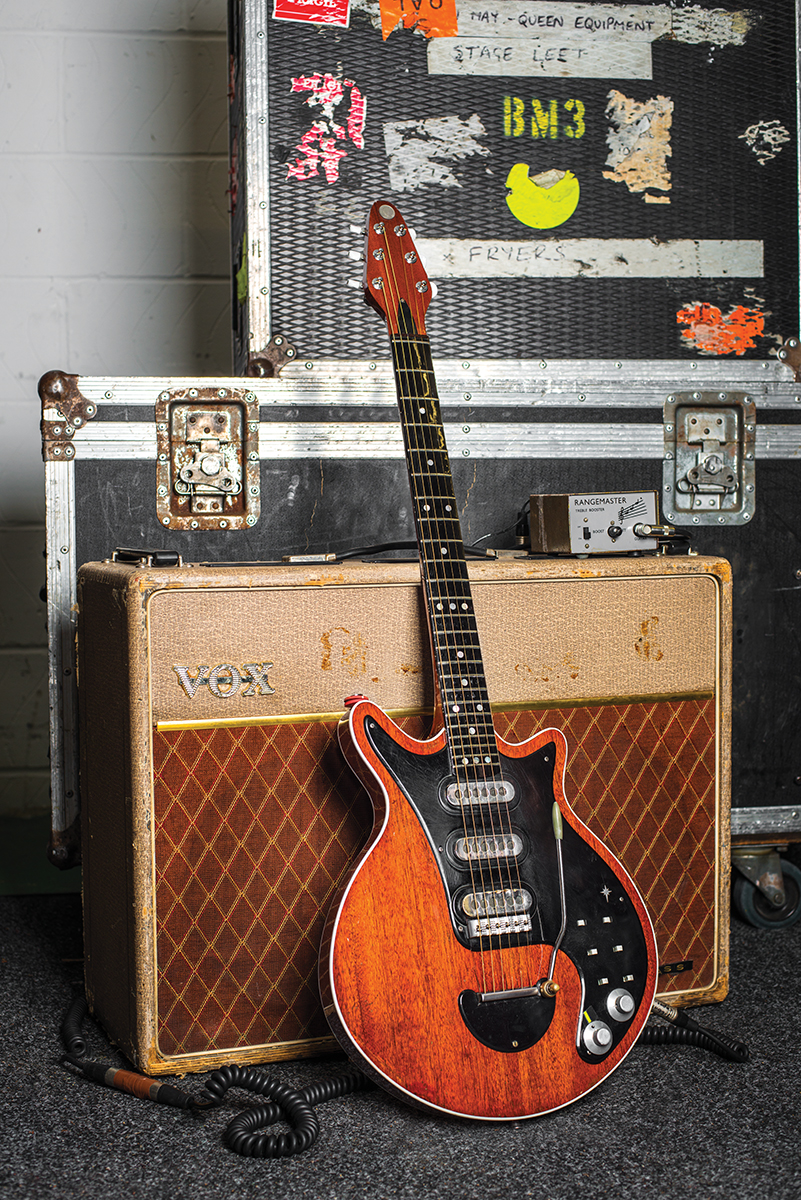
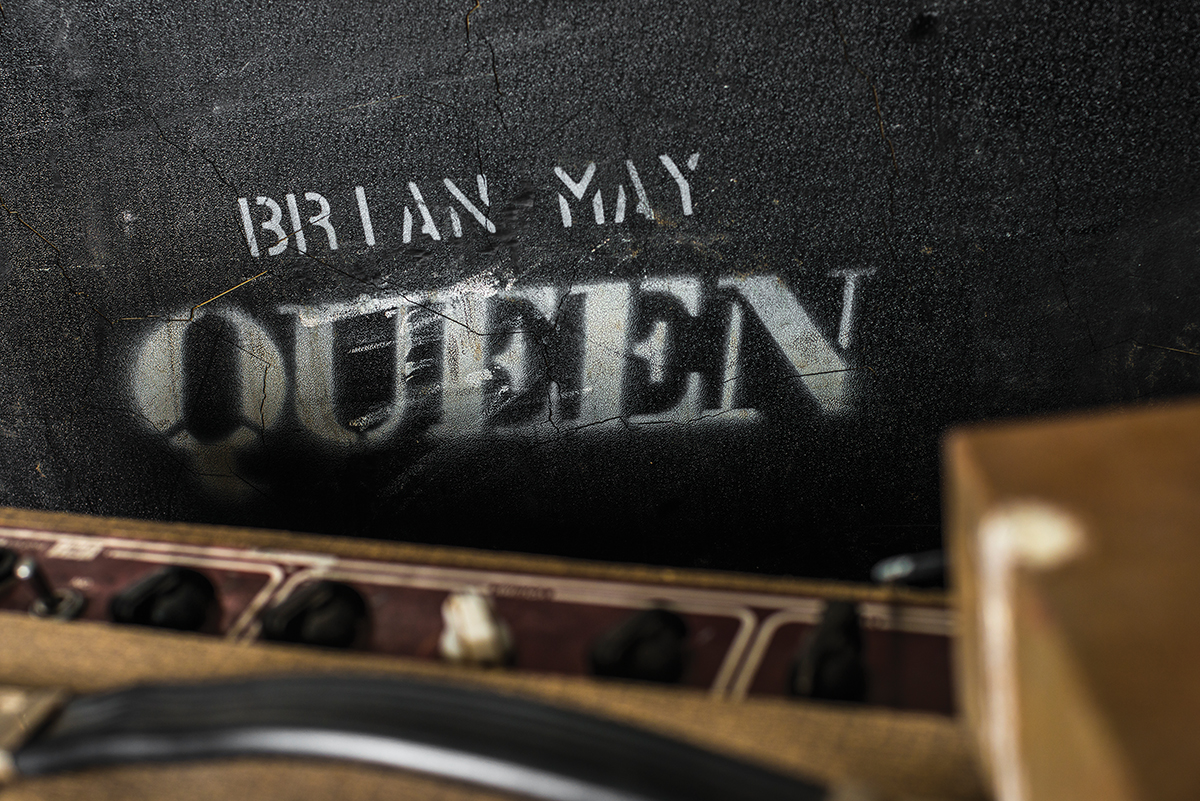
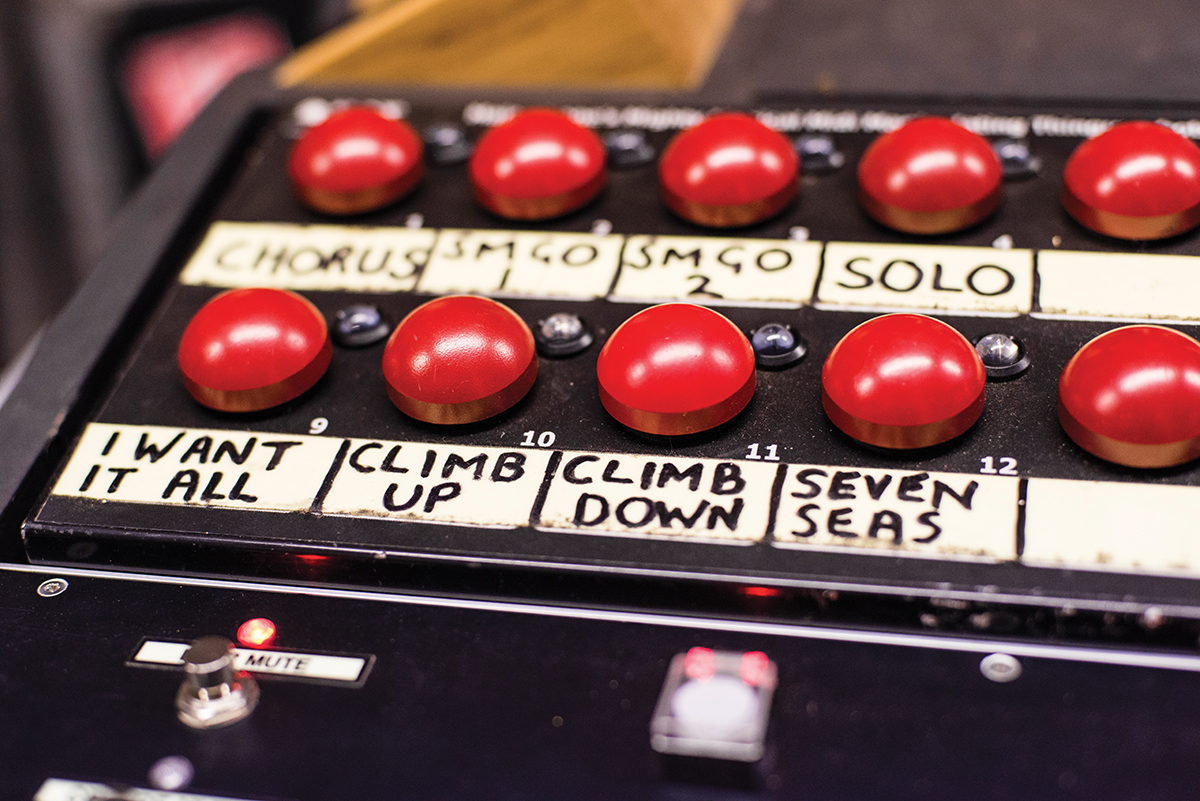
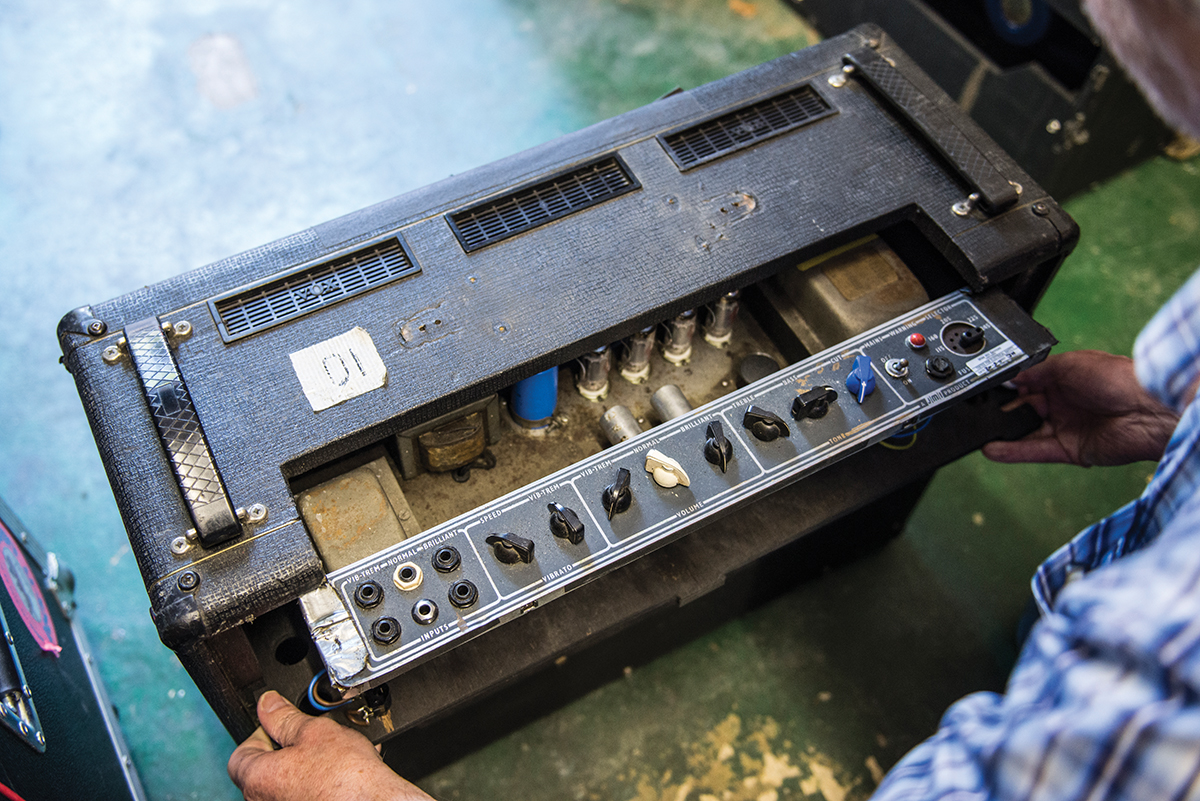
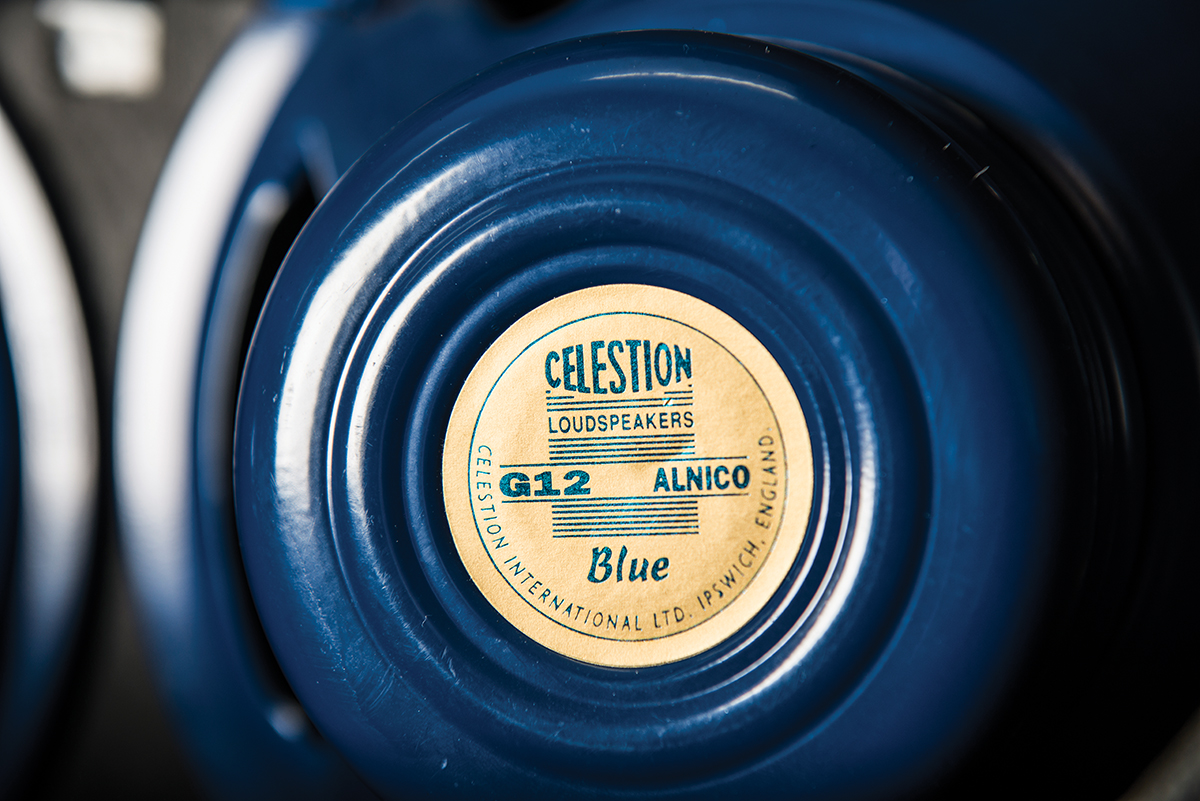
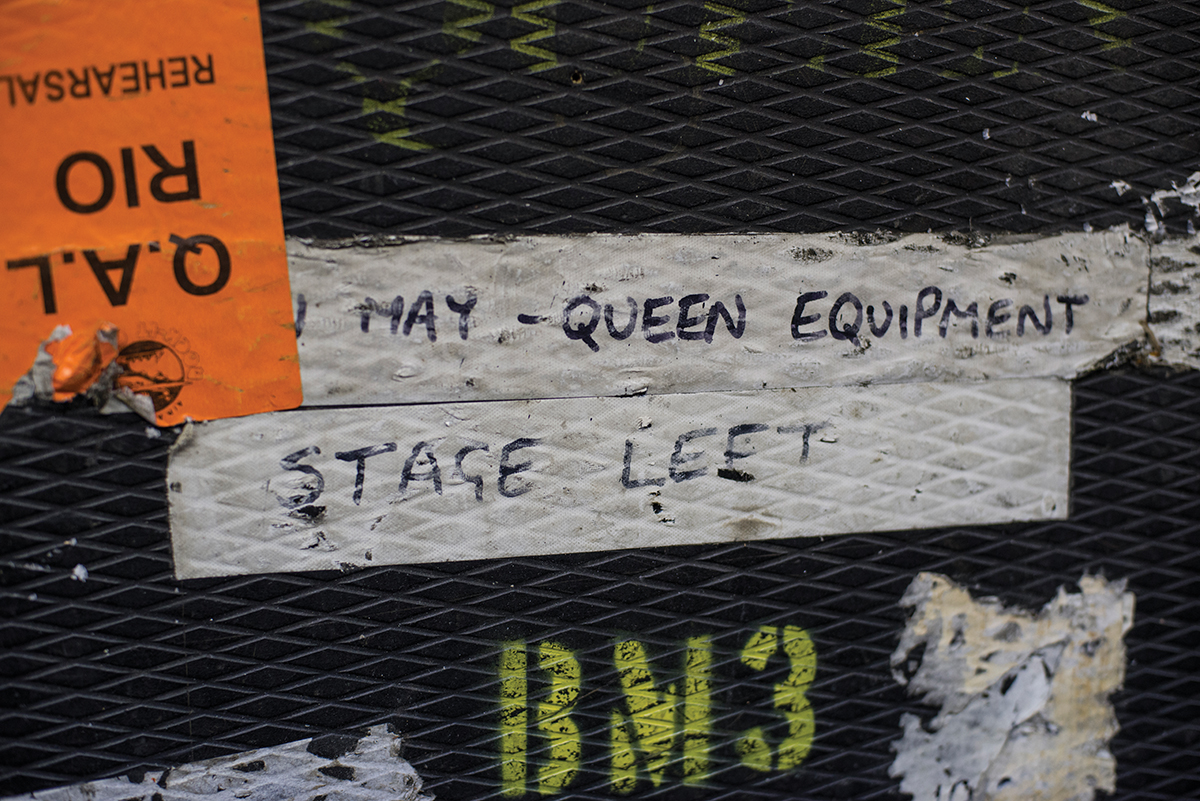
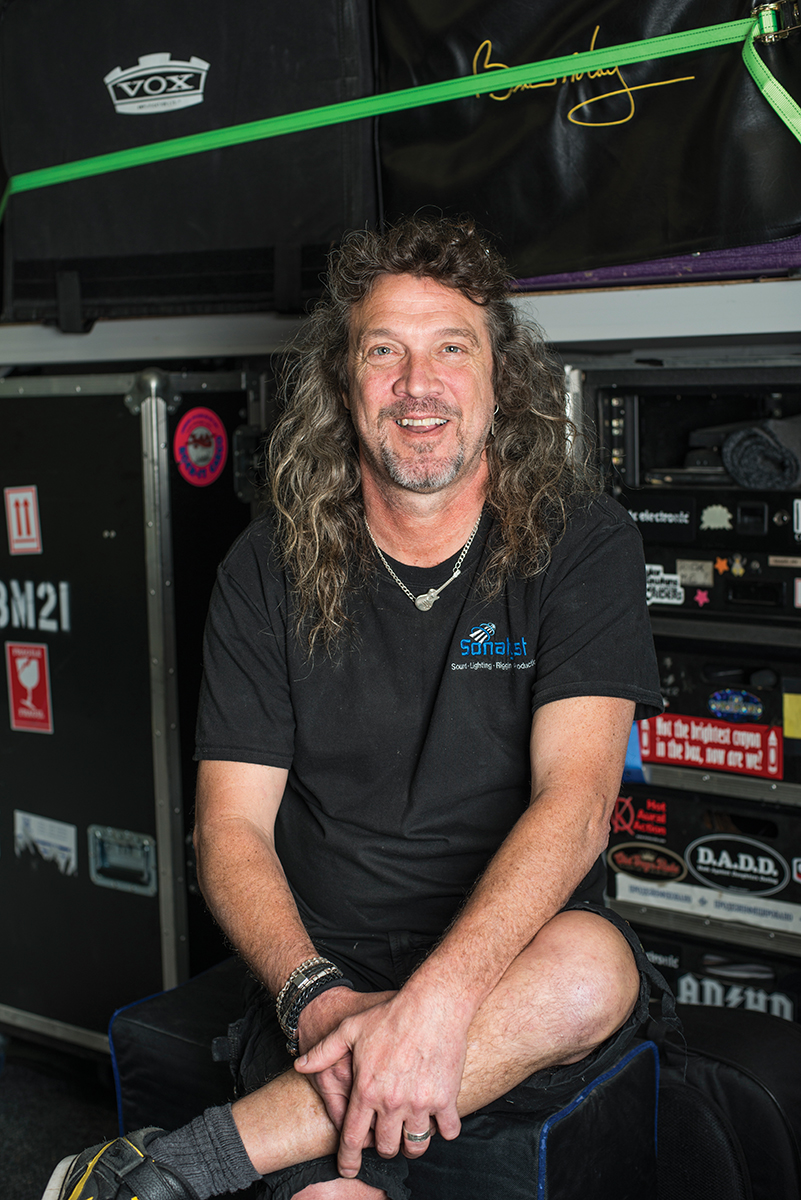
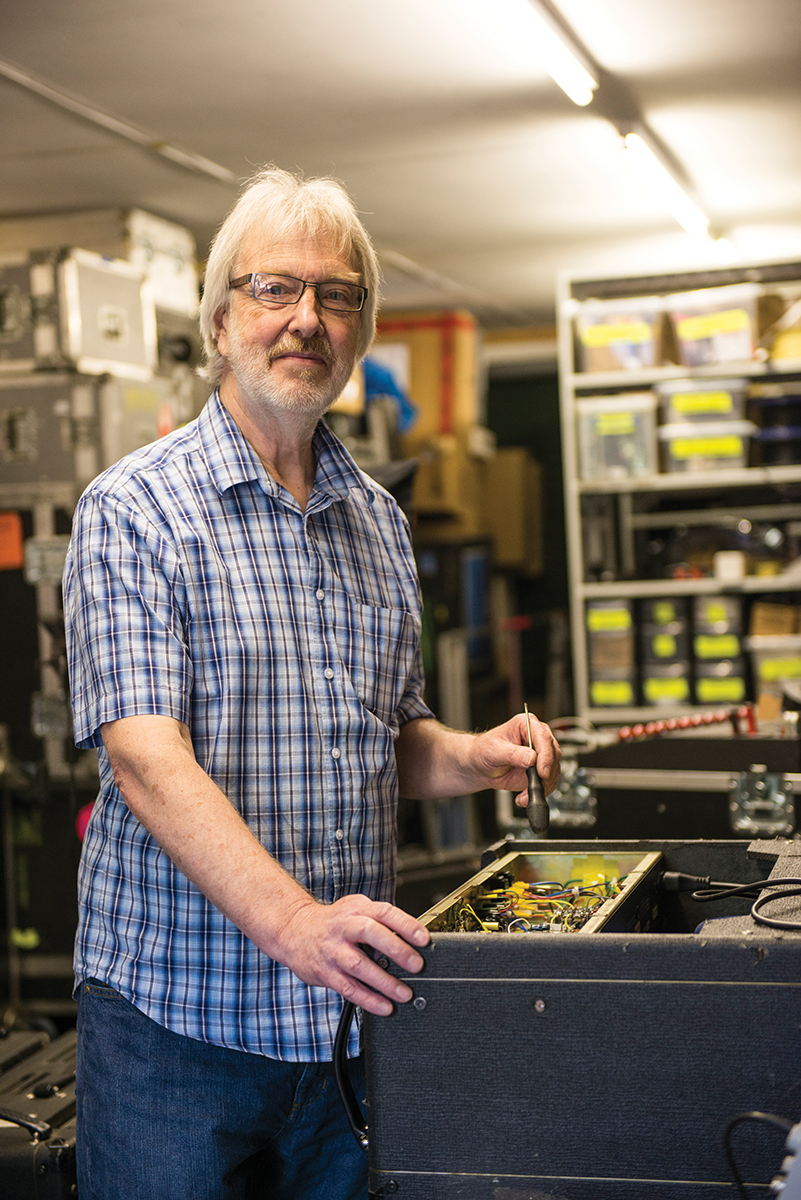
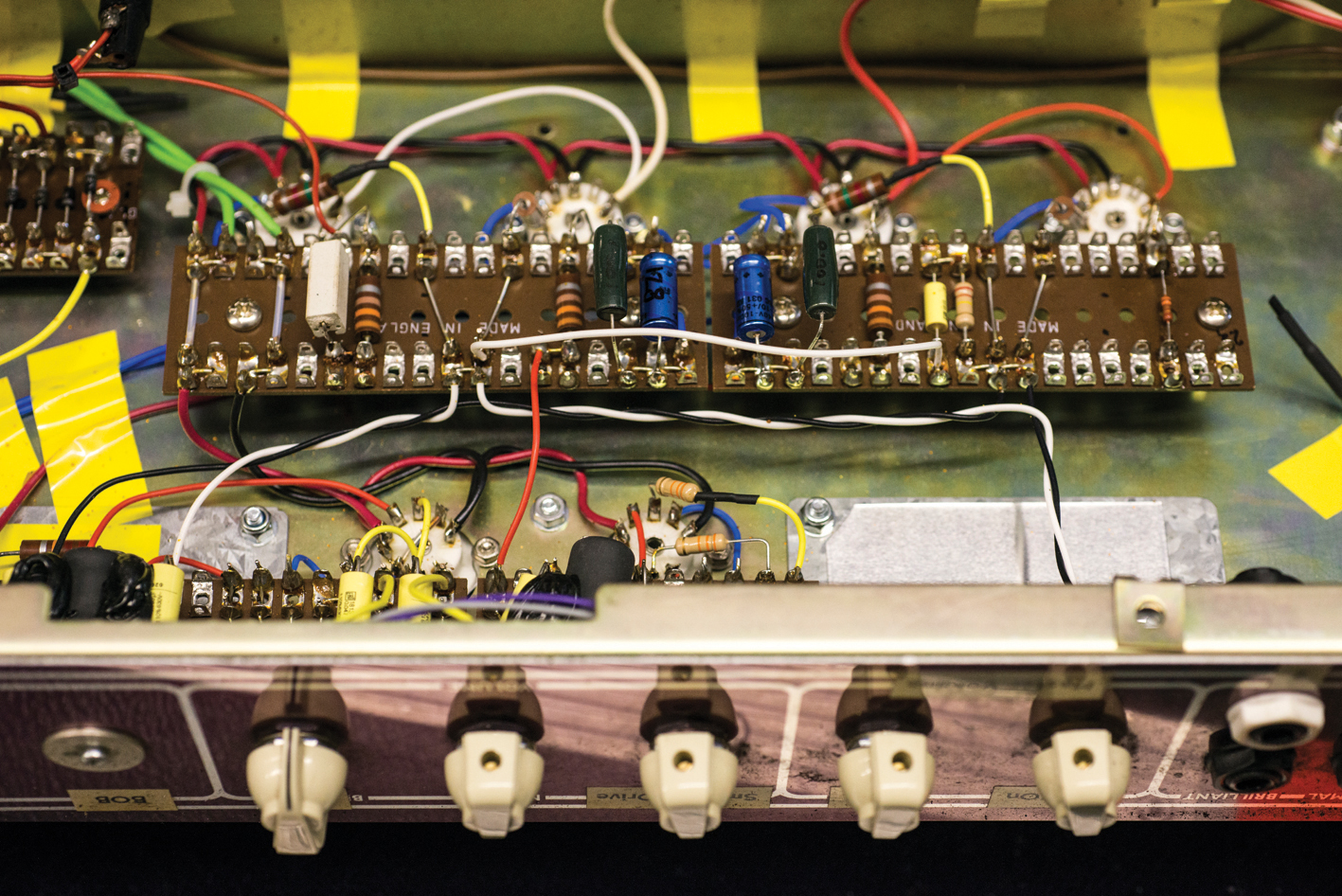
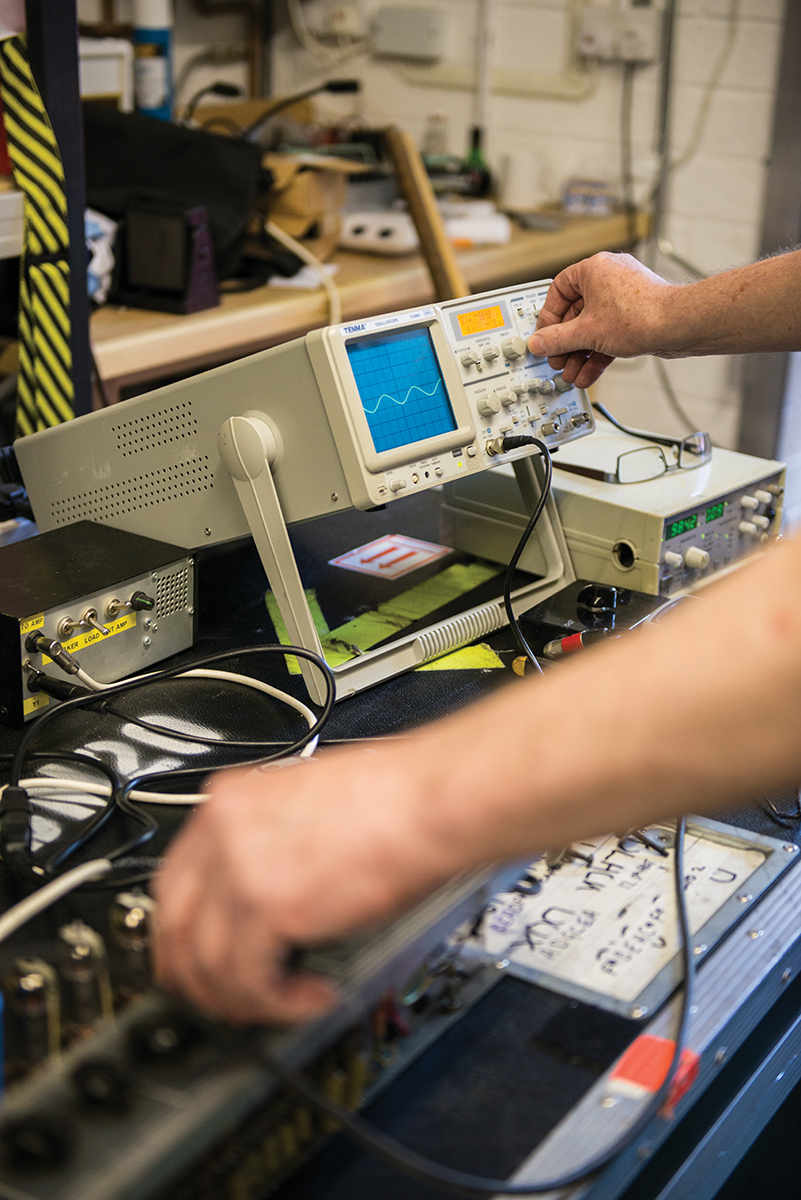
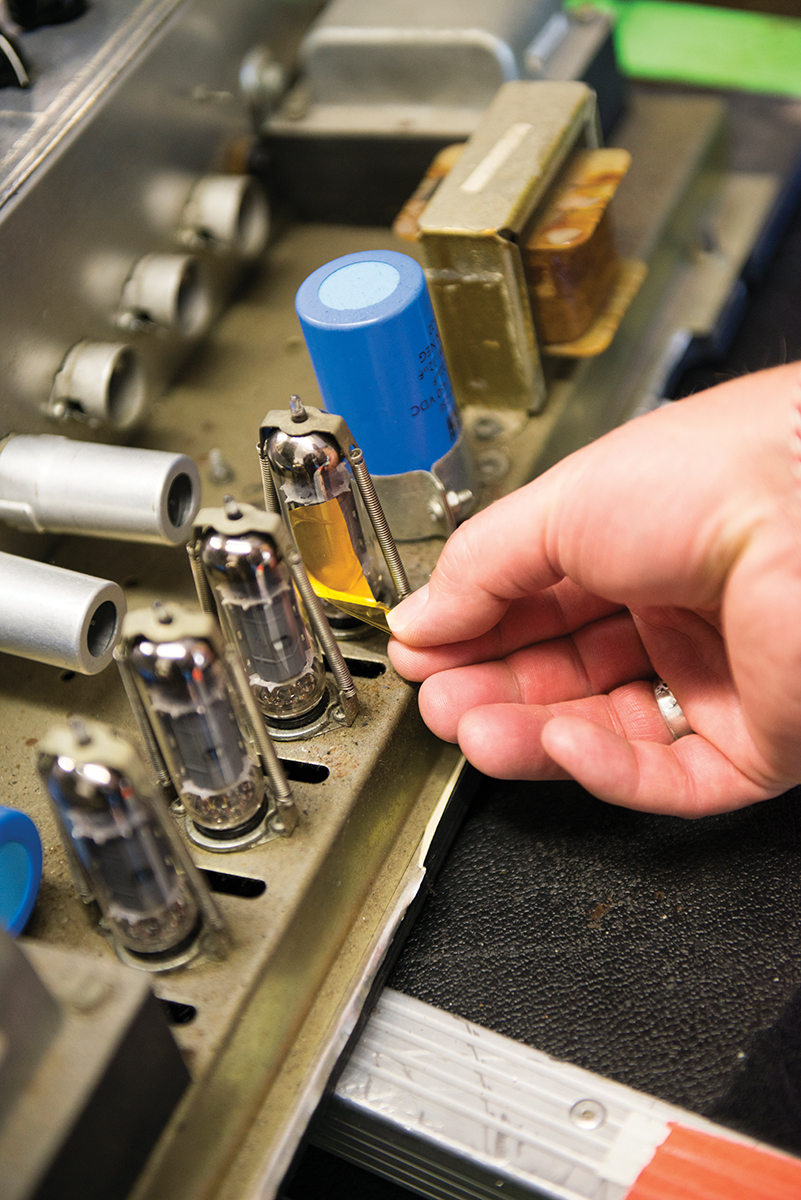
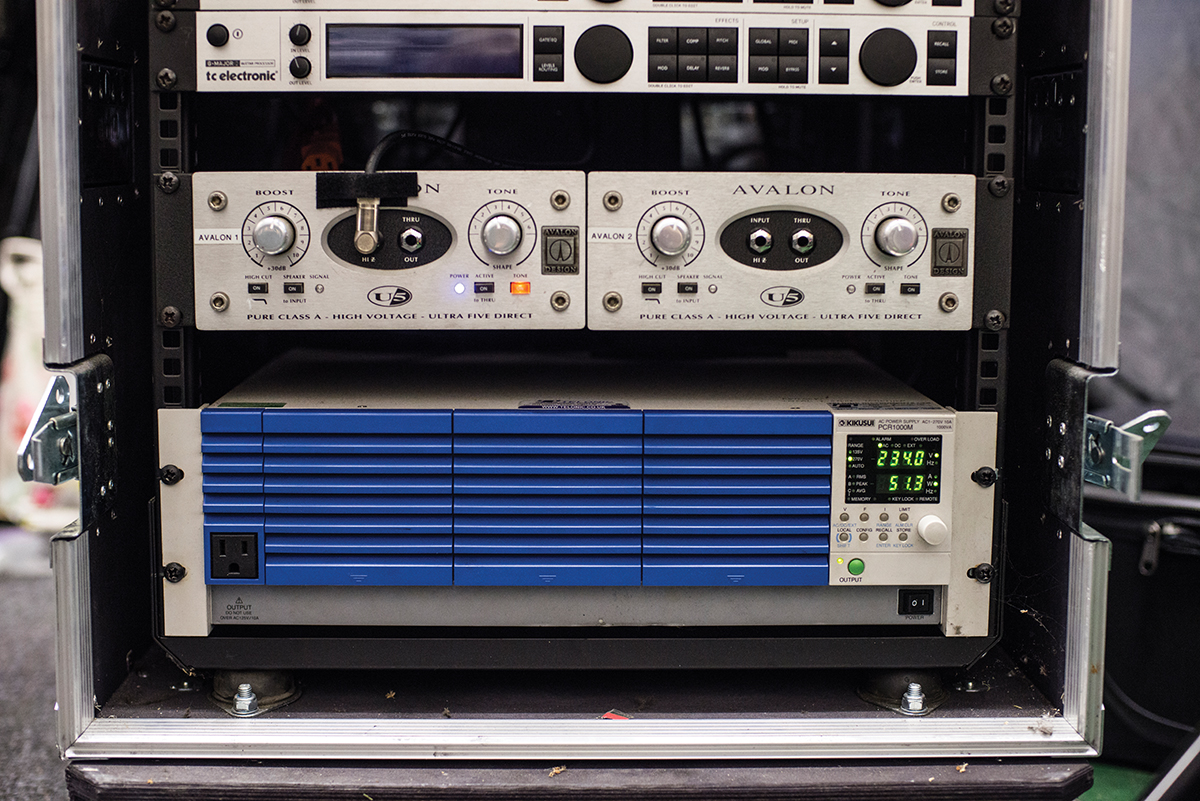
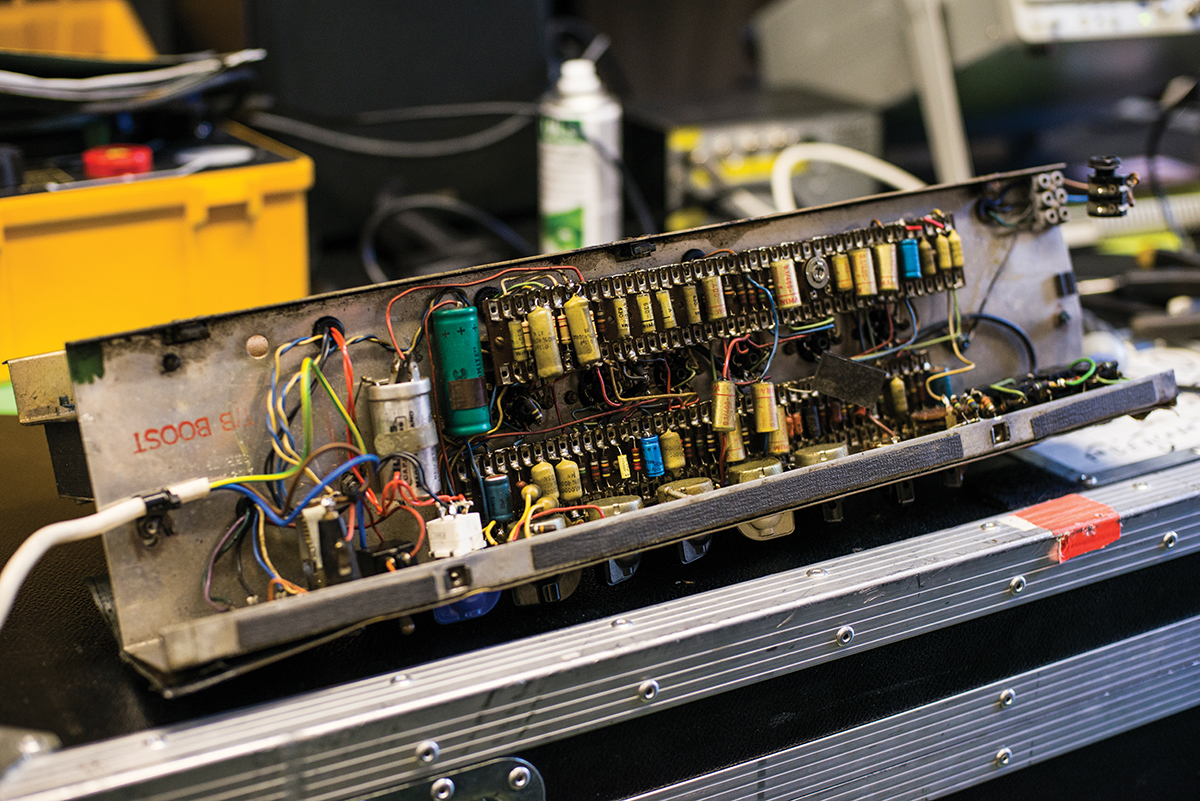
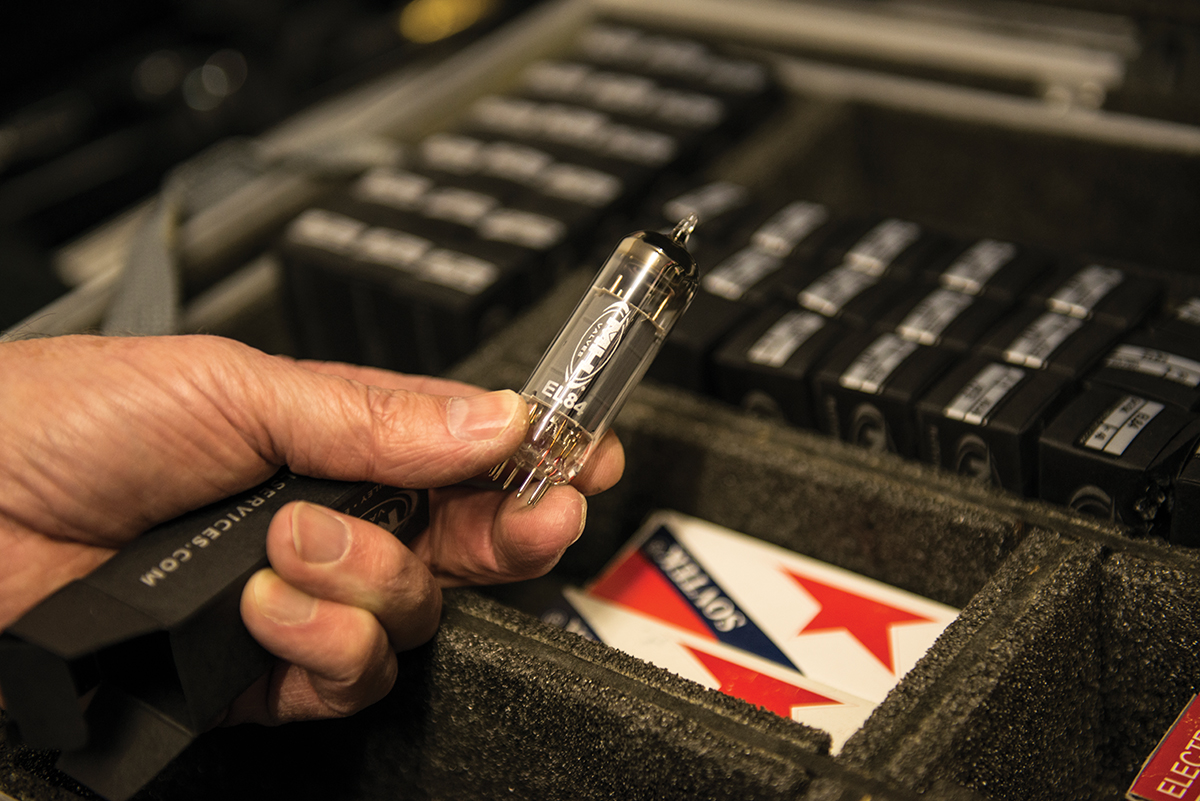
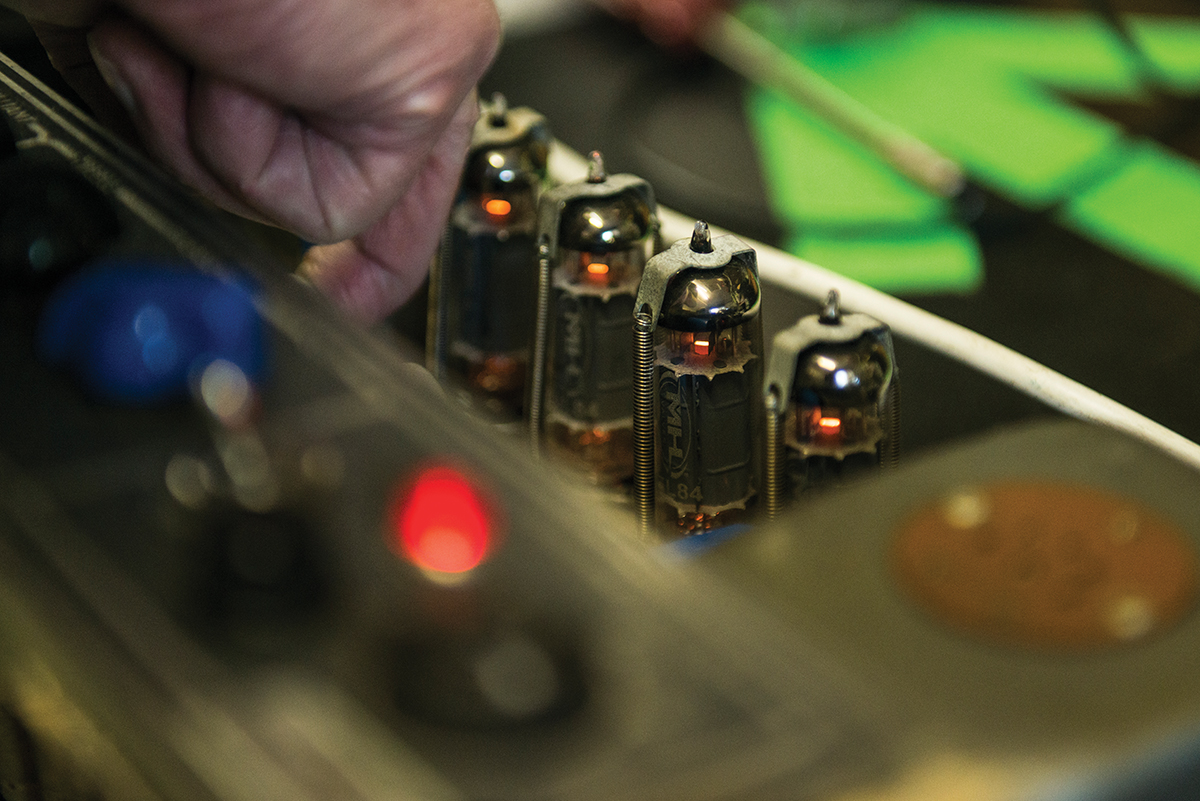
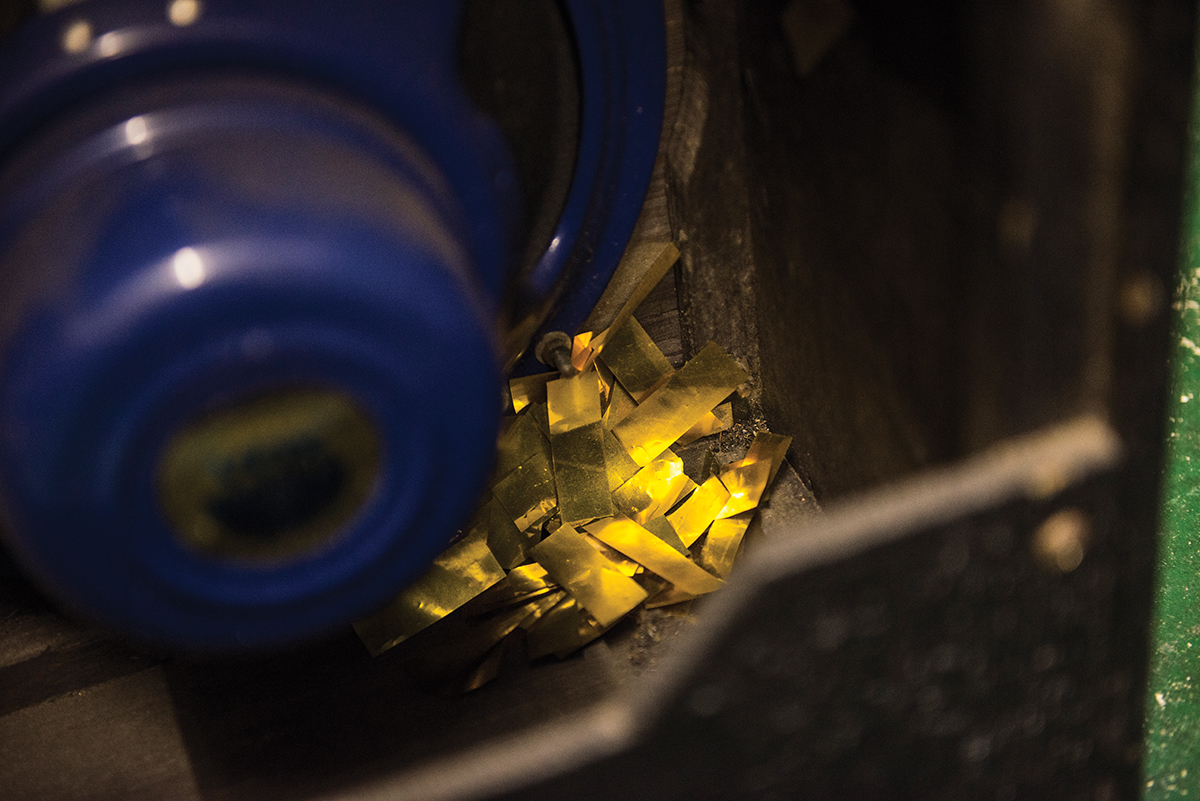
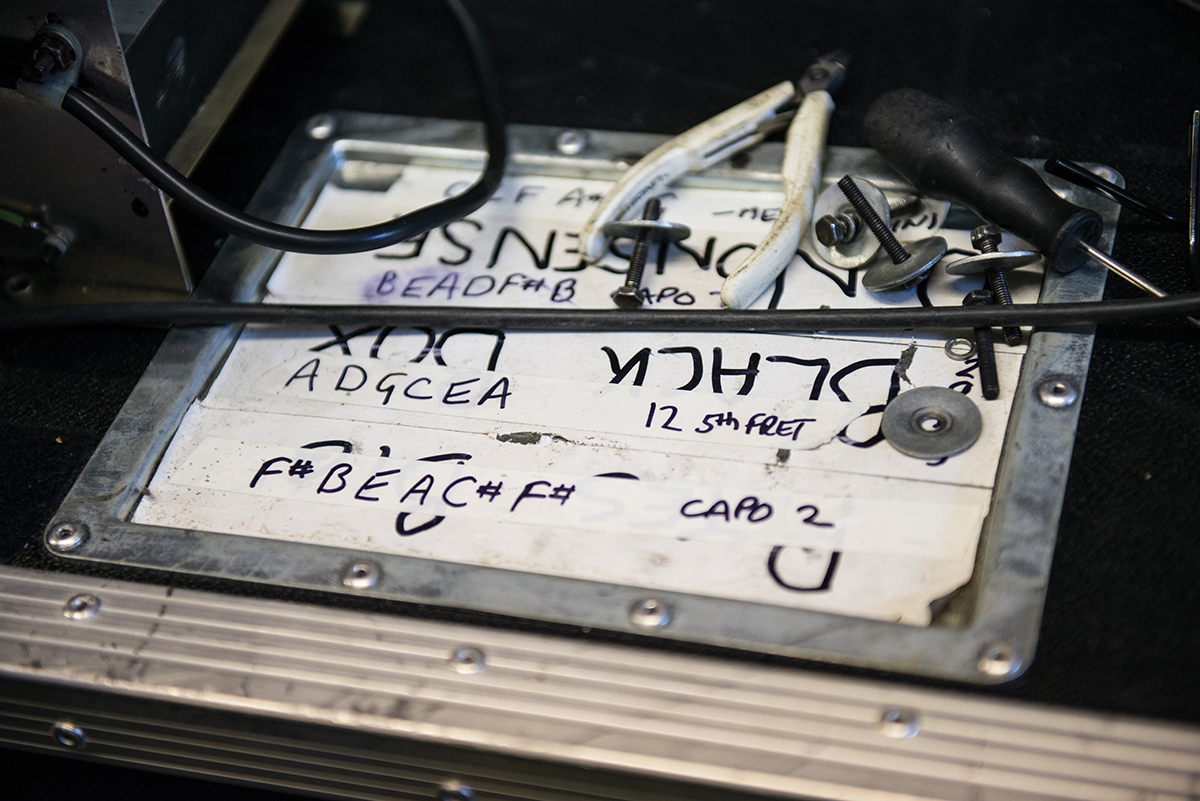
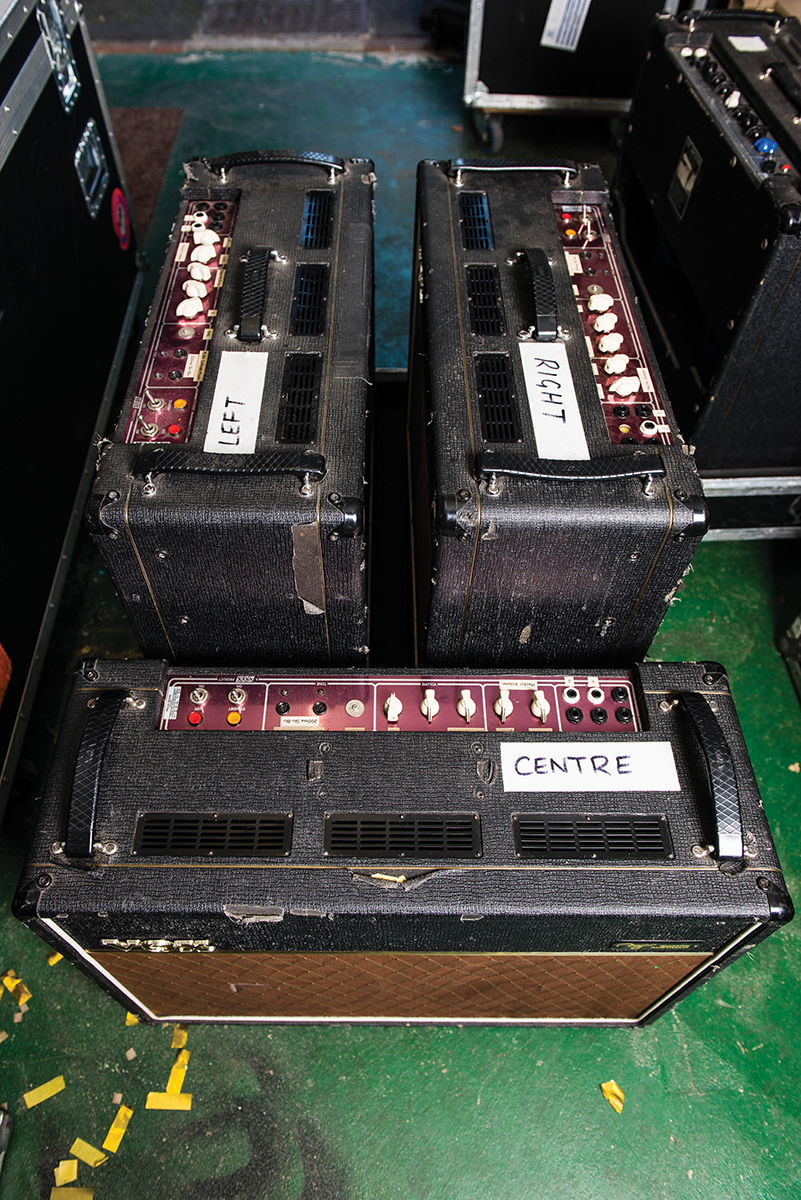













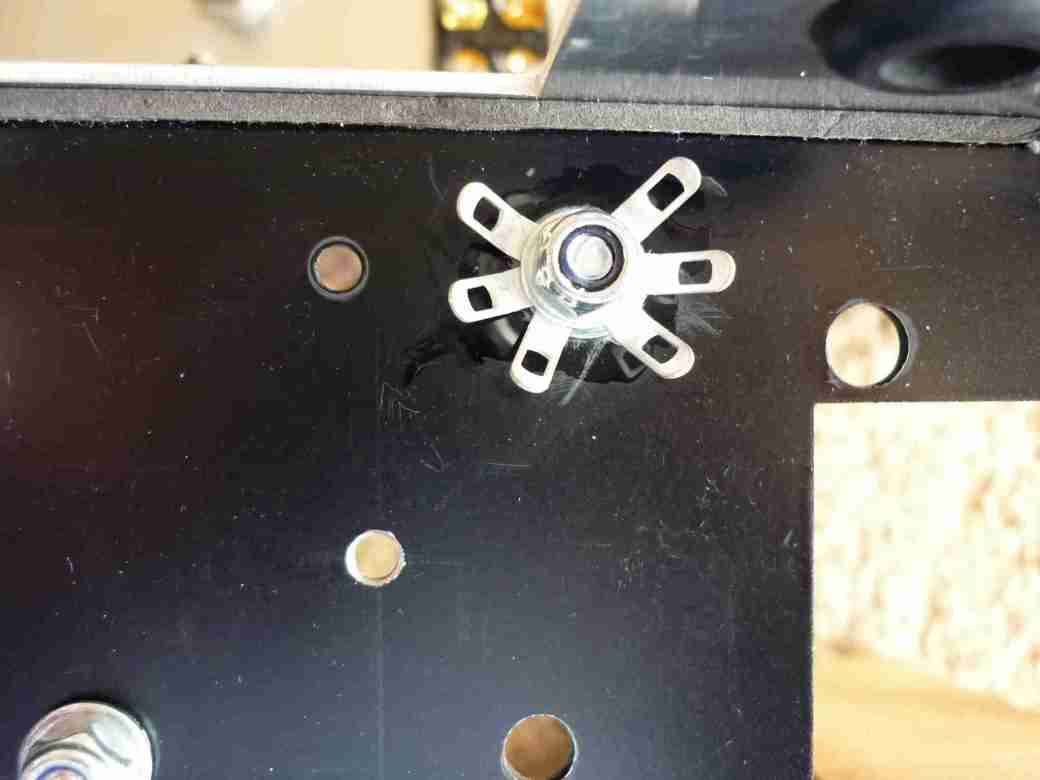



You must be logged in to post a comment.